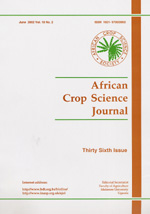
|
African Crop Science Journal
African Crop Science Society
ISSN: 1021-9730
EISSN: 1021-9730
Vol. 5, No. 1, 1997, pp. 31-38
|
 Bioline Code: cs97005
Bioline Code: cs97005
Full paper language: English
Document type: Research Article
Document available free of charge
|
|
|
African Crop Science Journal, Vol. 5, No. 1, 1997, pp. 31-38
| en |
Effect of soybean on subsequent maize grain yield in the guinea savanna zone of West Africa
Carsky, R.J.; Abaidoo, R.; Dashiell, K. & Sanginga, N.
Abstract
Two varieties of soybean (Glycine max (L.) Merr.) and a maize (Zea mays L.)
control crop were grown in replicated trials at 10 sites in the Guinea
savana of Nigeria in 1993 followed by a test crop of maize in 1994 with 20
or 60 kg N ha-1 to test effect of soybean on subsequent maize grain yield.
Maize grain yield increase following soybean was variable but the main
effect of previous soybean crop was positive even though the soybean was
not inoculated with rhizobia and the aboveground soybean residues, except
litter fallen before harvest, were exported from the fields, following the
present farmer practice. The yield increase following the medium duration
soybean variety (TGx1660-19F) was similar to that from 40 kg N ha-1
applied 4 weeks after planting to maize preceded by maize. The increase
following the early soybean variety (TGx1456-2E) was significantly (P<0.05)
smaller than that following the medium duration soybean variety. Total N in
the 0 to 10 cm depth of the previous TGx1660-19F plots (0.063%) was
significantly greater (P<0.05) than in the previous maize plots (0.058%)
when analysed for the combined sites. Thus, the effect of previous soybean
crop on maize grain yield was due mostly to residual N availability.
Additional research is justified to estimate how soybean crop management
influences the yield of subsequent maize in the savanna zone.
Keywords
Crop rotation, residue management, N fertilizer
|
| |
| fr |
Carsky, R.J.; Abaidoo, R.; Dashiell, K. & Sanginga, N.
Résumé
Deux varietes de soya (Glycine max (L) Merr.) et une varietede mas (Zea
mays L.) en temps que temoin ont ete cultivees en essais repliques sur 10
sites dans la savane Guineenne du Nigeria en 1993. Ces cultures ont ete
suivies d'une culture-test de mais en 1994 avec 20 ou 60 kg N ha-1.
L'augmentation de la production en graine de mais precedee d'une culture de
soya par rapport a la production du mais precedee d'une culture de mais
etait variable. L'effet principal de la culture de soya etait positif, bien
que le soya n'ait pas ete inocule et que le residu du soya aerien, a
l'exception du dechet tombe avant la recolte, ait ete exporte des champs a
l'example des pratiques courantes. L'augmentation de la recolte de mais
precedee de la variete de soja a duree intermediaire (TGx1660-19F) etait
semblable a l'augmentation obtenue par application de 40 kg N ha-1 sous
forme d'ureee 4 semaines apres la plantation de mais precede par du mais.
L'augmentation suivant la variete de soya precoce (TGx1456-2E) etait
significativement plus faible (P<0.05) que celle suivant la varietede
duree intermediaire. L'azote total une profondeur de 0-10cm dans les
parcelles de TGx1660-19F (0.063%) etait significativement plus elevee (P<
0.05) que dans les parcelles temoin (0.058%) lorsque l'anae est realisee
tous sites confondus. Par consequent, l'effet d culture de soya sur la
recolte posterieure de mais resulte principalement de la disponibilite
residuelle en azote. Des recherches additionnelles sont justifiees pour
estimer comment la conduite de la culture du soja influence la recolte
posterieure de mais dans la zone de savane Guineenne.
Mots Clés
rotation de culture, effet residuelle, equivalence de fertilisation d'azote, credits d'azote
|
| |
© Copyright 1997 - African Crop Science Society
|
|
